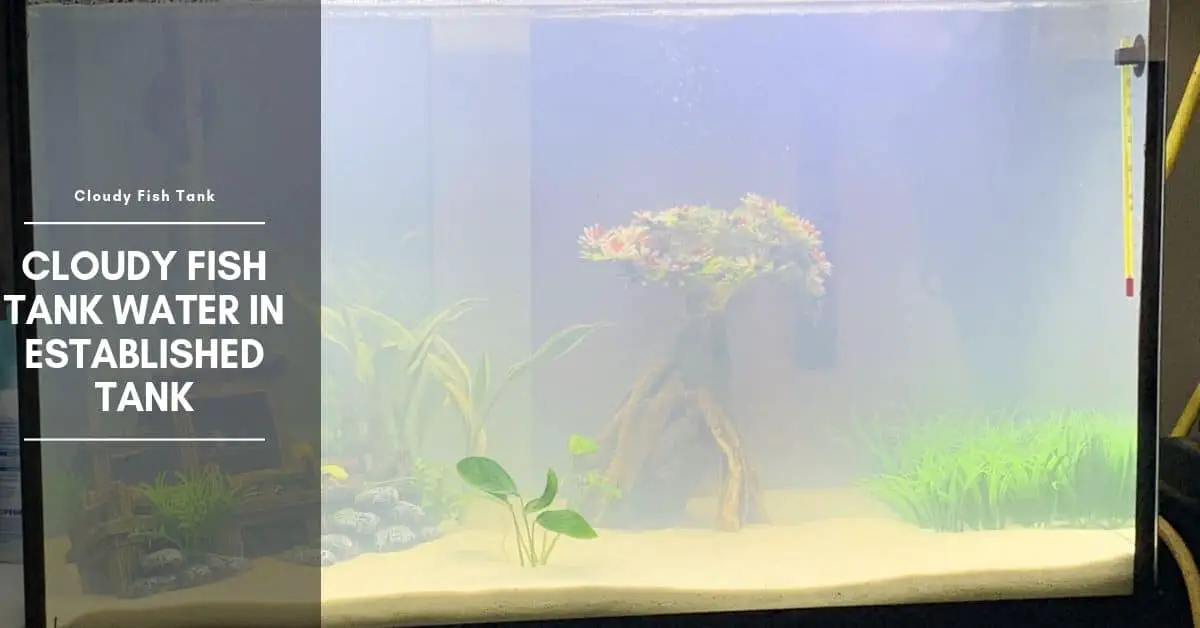Aquariums are beautiful until the water turns in color. Buying and setting up a fish tank is an achievement. What you have seen on TV is now actualized. However, the peace and natural feeling in your living won’t last for long before you notice the water turning grey.
You have always heard of aquariums being hectic, but your tank is beautiful, and you can’t understand why some people cannot follow instructions for proper installation.
You will
They will probably explain the “new tank syndrome” analogy and sell you some chemicals as quick fixes. It will work, but only for a few days. You can go on to online forums, and someone may suggest a water change. Again, it is only a solution for a few hours before you notice the cloudiness, probably more this time.
Cloudy fish tank water in an established tank can be frustrating, especially if you had all the big expectations of enhancing the look of your home. Some people give up after a few failed attempts. Instead of selling your tank at disposal price, find out the cause and how to fix it.
Why is my fish tank cloudy?
The greyish-whitish water is the biggest complaint with aquarium owners. To many, it appears and disappears mysteriously, sometimes overnight sometimes after a few days. It is common with new and established tanks.
The cloudiness can be thin to ignore but it will advance to a thick mist to blur vision. While it is almost obvious for any new fish tank, you have control by what you include and exclude in the water.
The primary cause of cloudiness is microscopic life in water. The bacteria, single-celled animals, and multicellular animals generate essential food for growing fish. While this is crucial for their growth, it is not good for display.
The cloud color may not be exactly the same because the type of food and environment differs in fish tanks. Usually, people add chlorine remover in fish tanks in an attempt to make the water as natural as possible for fish.
The essence of chlorine in water is to neutralize any microscopic life in water. Removing it is allowing the microscopic life to develop once again thus the cloudiness.
Besides, fish excrete regularly thus compromising the purity of the water. Also, excess food in a fish tank is an impurity. Adding food in a fish tank is also a way of feeding the microscopic life. The fact that you have neutralized the chlorine effect and the bacteria are feeding, the life will multiply hence the thickening of the cloudy substance.
API STRESS ZYME Freshwater and Saltwater Aquarium Cleaning Solution 16-Ounce Bottle
$16.18 (as of July 9, 2025 16:33 GMT +03:00 - More infoProduct prices and availability are accurate as of the date/time indicated and are subject to change. Any price and availability information displayed on [relevant Amazon Site(s), as applicable] at the time of purchase will apply to the purchase of this product.)API ACCU-CLEAR Freshwater Aquarium Water Clarifier 4-Ounce Bottle
30% OffAPI GENERAL CURE Freshwater and Saltwater Fish Powder Medication 10-Count Box
16% OffThe microscopic life will grow to maturity and die. Some will be born and the cycle continues. Changing the water or other quick fixes only clears the water instead of addressing the primary issue, life in the water. Toxic circumstances like the death of a fish can affect microscopic life; otherwise, life will sustain.

Fixing cloudy water in fish tank in established tank
The best solution to fish water tank cloudy is ignoring it. Don’t do anything. Let the microscopic life go through the full cycle to complete. It will be an unpleasant look and you might be doubting the cycle every day but be sure after a week, the cloud will be gone.
Typically, the cloudiness occurs after 2 to 3 days of setting up but can occur also in an established tank. The natural cycle will go on for the next 7 days and you will experience the beauty of an aquarium once again. During this period, only feed the fish a little bit. It should be your first step in dealing with cloudiness. It is the easiest process.
Here are some steps to deal with the new tank syndrome
Be patient
When dealing with aquariums, patience is key. You need to understand that you are taking fish out of their natural habitat to a glass box. Fish has to adapt to the new environment. Just like any living organism, nothing is constant; it is a cycle of events and adaptation that requires patience.
In the case of cloudy aquarium water, you have to take time and think of anything that might be amiss with your fish tank. Do not rush to throwing in chemicals or changing water as quick fixes. In fact, changing water might only be restarting the cycle.
Seeding
You can kick-start the life process by buying pre-packaged bacteria or gravel with pre-seeded bacteria to help with the flow of the natural process. Local aquarium stores also sell prepackaged bacteria cultures, which you simply add to your tank to help the fish adapt to the glass box as their new environment. If you can, add live plants to act as filters and cover the microscopic life.
Filter maintenance
A filter is the life support machine of an aquarium. You need to take good care of the filter; regularly clean the filter as per the manufacturer’s instruction. Most people prioritize changing the water and forget cleaning the filter. It is the best way to deal with cloudy fish tank water in an established tank.
Different reasons your aquarium can be cloudy
The three most common types for cloudy tanks are:
- Milky white cloudy aquarium water
- Green water
- Particulate in the water
Milky white cloudy aquarium water
The white fish tank cloudy water is going to be from a bacterial bloom. So if you’ve recently set up an aquarium, this is going to happen probably about a week to two weeks into having set up – meaning that your tank is cycling.
It can also happen when you haven’t established aquarium well, if you clean it too much, or if you over clean the filter, or something like that where you remove a lot of the biological media, clean it and remove the beneficial bacteria.
The fish tank is going to have to recycle; to regain a lot of the lost bacteria so that it can keep your tank healthy.
So basically, the white cloudiness is the bacteria will bloom, meaning that it is reproducing at a rapid rate. All of the bacteria are suspended in the water column. After some time, once it builds up enough bacteria to handle the bioload that your tank has, all of that bacteria will settle down into the substrate, onto the glass, and in the filter, and your water will clear back up.
So it’s not something that you need to worry too much about. The solution for that is time and patience. It will resolve itself, but while this is going on, make sure you’re testing your tank and keep track of your ammonia and your nitrites to make sure that the levels aren’t getting too high, which are detrimental to your fish.
Green water
If you look at a fish tank, and your water is visibly green, that is an algae bloom. That specific kind of algae is suspended in your water column, it doesn’t adhere to anything, is just make water very green.
Now, be that it is unsightly, it is not a bad thing. It is actually very beneficial for your fish, and won’t cause them any harm. A lot of people actually like the green water, because if you are breeding fish, you would want the fry in that green water, because that algae actually gives them something to feed on. It also makes them feel safe because predators aren’t going to be able to see them. It is actually also very healthy, because that algae is actually consuming nitrates and things like that – keeping that water quality very good.
How to get rid of green water?
There are a couple of ways to get rid of it. The two most prevalent ways are:
- UV sterilizer.
- Turn off the lights on your tank.
UV sterilizer forces water to pass through a UV ray, and it genetically modify is the genetic code of the algae. So that it can no longer reproduce, at that point, what will happen is the algae will pass through your filter media, and your filter media will remove it from the water. Eventually, after probably a couple of days, your water will be clear again.
The other option would be to turn off the lights on your tank and completely black it out and cover it up with a large blanket. Make sure no light gets in there, and you’re going to leave the lights off for a couple of days.
What’s going to happen is there’s no light getting into the tank, which means that the algae has no light to survive on and will eventually die. And then the same thing, once the algae die, the filter will pick it up and clean your water, and then you don’t have to worry too much about it. If you want to, you could put some filter floss in there, and it will clean your water real good. It will polish it, and you can clean it up that way.
Particulate in the water
If you can see that there’s a lot of particulate in the water floating around, it’s going to be from either vacuuming your substrate out or cleaning your filter.
A lot of that gunk is gonna become waterborne, and it’s going to just float around in your water. It’s going to be a little unsightly and it’s not harmful for your fish.
The easiest way to clean that up is by getting some filter floss. You just take a handful of that, stick it in your canister filter and it’ll pull that particular out. Another option is filter pads.

Hi, my name is Sean, and I’m the primary writer on the site. I’m blogging mostly about freshwater and saltwater aquariums, fish, invertebrates, and plants. I’m experienced in the fishkeeping hobby for many years. Over the years I have kept many tanks, and have recently begun getting more serious in wanting to become a professional aquarist. All my knowledge comes from experience and reading forums and a lot of informative sites. In pursuit of becoming a professional, I also want to inspire as many people as I can to pick up this hobby and keep the public interest growing.
Read more about Sean.
Please join also my Facebook group.
















